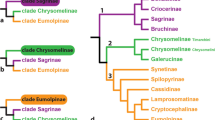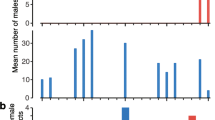Summary
Sex pheromone communication in the nine European species of small ermine moths (Yponomeuta) is reviewed in regard to the potential role of pheromones in the speciation process. Six of the nine species studied (viz.,Y. evonymellus, Y. cagnagellus, Y. padellus, Y. irrorellus, Y. plumbellus, andY. vigintipunctatus) use a mixture of (E)-11-and (Z)-11-tetradecenyl acetate in different ratios as primary pheromone components, with combinations of tetradecyl acetate, (Z)-9-tetradecenyl acetate, (Z)-11-hexadecenyl acetate and the corresponding alcohols of the acetates as additional pheromone components. Analysis of (Z)- to (E)-11-tetradecenyl acetate ratios produced by individual females of these species demonstrated significant variation among females of all species. However, the ranges of ratios produced byY. cagnagellus, Y. irrorellus, andY. plumbellus, sharing the same host-plant species, spindle tree, did not overlap. Niche separation of all six species mentioned required consideration of at least one additional pheromone component or of temporal aspects. The remaining three species,i.e. Y. malinellus, Y. mahalebellus andY. rorellus, have pheromones that differ qualitatively.
Biosynthetic routes to the pheromone components identified are proposed on the basis of fatty acid pheromone precursors found in the pheromone glands. A phylogenetic tree for the genus is constructed based on allozyme frequency data and changes in pheromone composition are superimposed on this tree. We suggest that the ancestral ermine moth pheromone is a mixture of (Z)-11- and (E)-11-tetradecenyl acetate and the corresponding alcohols, and a scenario of how present-day patterns evolved is outlined. The pheromone differences among the three species using spindle tree as their host-plant might have evolved throughreproductive character displacement upon secondary contact between populations that had already diverged genetically in allopatry. Pheromone differences within the so-calledpadellus-complex (includingY. cagnagellus, Y. mahalebellus, Y. malinellus, Y. padellus, andY. rorellus) in which species might have originated sympatrically, may have evolved byreinforcing selection as these species still hybridise and produce viable offspring when confined in cages. The role of pheromones in reproductive isolation amongYponomeuta species is emphasised by (1) the function of pheromone components of some of the species as behavioural antagonists to other species, (2) the cross-attraction under experimental conditions between allochronic species with similar pheromones, and (3) the formation of hybrids in the laboratory between species that are isolated in nature by pheromone differences.
Similar content being viewed by others
References
Arduino P, Bullini L (1985) Reproductive isolation and genetic divergence between the small ermine mothsYponomeuta padellus andYponomeuta malinellus (Lepidoptera: Yponomeutidae). Atti Acad Naz Lincei 18:33–61
Barton NH, Charlesworth B (1984) Genetic revolutions, founder effects, and speciation. Annu Rev Ecol Syst 15:133–164
Bestmann HJ, Herrig M, Attygalle AB (1987) Terminal acetylation in pheromone biosynthesis byMamestra brassicae L. (Lepidoptera: Noctuidae). Experientia 43:1033–1034
Bjostad LB, Roelofs WL (1983) Sex pheromone biosynthesis inTrichoplusia ni: key steps involve delta-11 desaturation and chain-shortening. Science 220:1387–1389
Bjostad LB, Roelofs WL (1986) Sex pheromone biosynthesis in the redbanded leafroller moth, studies by mass labeling with stable isotopes and analysis with mass spectrometry. J Chem Ecol 12:431–450
Butlin R (1987) Speciation by reinforcement. Trends Ecol Evol 2:8–13
Butlin R (1989) Reinforcement of premating isolation. Pp 158–179in Otte D, Endler JA (eds) Speciation and its Consequences. Sunderland/MA Sinauer
Dijkerman HJ (1990) Suitability of eightYponomeuta-species as hosts ofDiadegma armillata. Entomol exp appl 54:173–180
Du J-W, Löfstedt C, Löfqvist J (1987) Repeatability of pheromone emissions from individual female ermine mothsYponomeuta padellus andY. rorellus. J Chem Ecol 13:1431–1441
Feder JL, Chilcot A, Bush GL (1990) The geopgraphic pattern of genetic differentiation between host associated populations ofRhagoletis pomonella (Diptera: Tephritidae) in the eastern United States and Canada. Evolution 44:570–94
Friese G (1960) Revision der palaearktischen Yponomeutidae unter besonderer Berücksichtigung der Genitalien (Lepidoptera). Beitr Entomol 10:1–131
Gerrits-Heybroek EM, Herrebout WM, Ulenberg SA, Wiebes JT (1978) Host plant preferences of five species of small ermine moths. Entomol exp appl 24:360–368
Gershenson ZS (1967) Karyotype of the willow ermine mothYponomeuta rorellus HB. (Lepidoptera, Yponomeutidae). Tsitol Genet 1:79–80 (in Russian)
Grant V (1971) Plant Speciation. New York: Columbia University Press
Greenfield MD, Karandinos MG (1979) Resource partitioning of the sex communication channel in clearwing moths (Lepidoptera:Sesiidae) of Wisconsin. Ecol Monogr 49:403–426
Hendrikse A (1978) Factors influencing the courtship behaviour ofYponomeuta vigintipunctatus (Retz.). Neth J Zool 28:139–149
Hendrikse A (1979) Activity patterns and sex pheromone specificity as isolating mechanisms in eight species ofYponomeuta (Lepidoptera: Yponomeutidae). Entomol exp appl 25:172–180
Hendrikse A (1986) Intra- and interspecific sex pheromone communication in the genusYponomeuta Latreille. Physiol Entomol 11:159–169
Hendrikse A (1988) Hybridization and sex-pheromone responses among menbers of theYponomeuta padellus-complex. Entomol exp appl 48:213–223
Hendrikse A, Vos-Bünnemeyer E (1987) Role of host-plant stimuli in sexual behaviour of small ermine moths (Yponomeuta). Ecol Entomol 12:363–371
Herrebout WM, Van De Water TPM (1982) The effect of hostplant on pheromone communication in a small ermine moth,Yponomeuta cagnagellus (Lepidoptera: Yponomeutidae). Med Fac Landbouww Rijksuniv Gent 47:503–509
Herrebout WM, Menken SBJ (1990) Preliminary data on the origin of small ermine moths introduced into North America (Lepidoptera, Yponomeutidae). Proc Exper & Appl Entomol 1:146–151
Herrebout WM, Kuijten PJ, Wiebes JT (1976) Small ermine moths of the genusYponomeuta and their host relationships (Lepidoptera: Yponomeutidae). Symp Biol Hung 16:91–94
Jong MCM de (1987) A direct search approach to characterize the sex pheromone composition giving maximal male response. Physiol Entomol 12:11–22
Jong, MCM de (1988) Evolutionary approaches to insect communication systems (Thesis). Leiden, The Netherlands: University of Leiden
Jurenka RA, Roelofs WL (1989) Characterization of the acetyltransferase used in pheromone biosynthesis in moths: specificity for the Z isomer in Tortricidae. Insect Biochem 19:639–644
Kaneshiro KY (1980) Sexual isolation, speciation and the direction of evolution. Evolution 34:437–444
Lanier GN, Burkholder WE (1974) Pheromones in Speciation of Coleoptera. Pp 161–189in Birch MC (ed) Pheromones. New York: North-Holland/American Elsevier
Littlejohn MJ (1981) Reproductive isolation: a critical review. Pp 298–334in Atchley WR & Woodruff DS (eds) Evolution and Speciation. Cambridge: Cambridge University Press
Löfstedt C (1986) Sex pheromones and reproductive isolation in moths. Ent Tidskr 107:125–137
Löfstedt C (1987) Behaviour of small ermine moths in overlapping pheromone plumes. Pp 37–39in Arn H (ed) Mating Disruption — Behaviour of Moths and Molecules. WPRS Bulletin 1987/X/3. Paris: OILB-SROP
Löfstedt C (1991) Evolution of moth pheromones. In pressin Proceedings of Conference on Insect Chemical Ecology. Tábor, Czechoslovakia
Löfstedt C, Herrebout WM (1988) Sex pheromones of three small ermine moths found on spindle tree. Entomol exp appl 46:29–38
Löfstedt C, Van Der Pers JNC (1985) Sex pheromones and reproductive isolation in four European small ermine moths. J Chem Ecol 11:649–666
Löfstedt C, Herrebout WM, Du J-W (1986a) Evolution of the ermine moth pheromone tetradecyl acetate. Nature 323:621–623
Löfstedt C, Löfqvist J, Lanne BS, Van Der Pers JNC, Hansson BS (1986b) Pheromone dialects in European turnip mothsAgrotis segetum. Oikos 46:250–257
Löfstedt C, Hansson BS, Roelofs WL, Bengtsson BO (1989) No linkage between genes determining female pheromone production and male olfactory response in the European corn borerOstrinia nubilalis. Genetics 123:553–556
Löfstedt C, Hansson BS, Dijkerman HJ, Herrebout WM (1990) Behavioural and electrophysiological activity of unsaturated analogues to the pheromone tetradecyl acetate in the small ermine mothYponomeuta rorellus. Physiol Entomol 15:47–54
Mayr E (1963) Animal Species and Evolution. Cambridge/MA Harvard University Press
McDonough LM, Davis HG, Smithhisler CL, Voerman S, Chapman PS (1990) Apple ermine moth,Yponomeuta malinellus Zeller: two components of female sex pheromone gland highly effective in field trapping tests. J Chem Ecol 16:477–486
Menken SBJ (1980) Inheritance of allozymes inYponomeuta, II. Interspecific crosses within thepadellus-complex and reproductive isolation. Proc Kon Ned Acad Wet (C) 83:425–431
Menken SBJ (1982) Biochemical genetics and systematics of small ermine moths (Lepidoptera: Yponomeutidae). Z Zool Syst Evolforsch 20:131–143
Menken SBJ (1987) Is the extremely low heterozygosity level inYponomeuta rorellus caused by bottlenecks? Evolution 41:630–637
Menken SBJ (1989) Electrophoretic studies on populations, host races, and sibling species in insect pest species. Pp 181–201in Loxdale H, Den Hollander J (eds) Electrophoretic Studies in Insect Pests. Oxford: Clarendon Press
Menken SBJ, Herrebout WM, Wiebes JT (1991) Small ermine moths: their host relations and evolution. Annu Rev Entomol (in press)
Nilsson N-O, Löfstedt C, Dävring L (1988) Chromosome number and an unusual inheritance of sex chromosomes in species ofYponomeuta (Yponomeutidae; Lepidoptera). Hereditas 108:259–265
Paterson HEH (1978) More evidence against speciation by reinforcement. Afr J Science 74:369–371
Paterson HEH (1985) The recognition concept of species. Pp 21–29in Vrba ES (ed) Species and Speciation. Pretoria: Transvaal Museum
Peterson SC, Herrebout WM, Kooi RE (1990) Chemosensory basis of host colonization by small ermine moth larvae. Proc Kon Ned Acad Wet (C) 93:282–294
Povel GDE (1984) The identification of the European small ermine moths, with special reference to theYponomeuta padellus-complex (Lepidoptera: Yponomeutidae). Proc Kon Ned Acad Wet (C) 87:149–180
Povel GDE (1986) Pattern detection within theYponomeuta padellus-complex of the European small ermine moths (Lepidoptera, Yponomeutidae). I. Biometric description and recognition of groups by numerical taxonomy. Proc Kon Ned Akad Wet (C) 89:425–41
Roelofs WL, Bjostad LB (1984) Biosynthesis of lepidopteran pheromones. Bioorganic Chemistry 12:279–298
Roelofs WL, Comeau A (1969) Sex pheromone specificity: taxonomic and evolutionary aspects in Lepidoptera. Science 165:398–400
Roelofs WL, Wolf WA (1988) Pheromone biosynthesis in Lepidoptera. J Chem Ecol 14:2019–2031
Roelofs WL, Glover T, Tang X-H, Sreng I, Robbins P, Eckenrode C, Löfstedt C, Hansson B, Bengtsson BO (1987) Sex pheromone production and perception in European corn borer moths is determined by both autosomal and sex-linked genes. Proc Natl Acad Sci USA 84:7585–7589
Rogers JS (1984) Deriving phylogenetic trees from allele frequencies. Syst Zool 33:52–63
Tauber CA, Tauber MJ (1989) Sympatric speciation in insects: perception and perspective. Pp 307–344in Otte D, Endler JA (eds) Speciation and its Consequences. Sunderland/Ma: Sinauer
Thorpe WH (1929) Biological races inHyponomeuta padella L. J Linn Soc Zool 36:621–634
Van Der Pers JNC (1982) Comparison of single cell responses of antennal sensilla trichodea to sex attractants in nine European small moths (Yponomeuta spp.). Entomol exp appl 31:255–264
Van Drongelen W, van Loon JJA (1980) Inheritance of gustatory sensitivity in F1 progeny of crosses betweenYponomeuta cagnagellus andYponomeuta malinellus. Entomol exp appl 24:199–203
Wiebes JT (1976) The speciation process in the small ermine moths. Neth J Zool 26:440
Wolf WA, Roelofs WL (1987) Reinvestigation confirms action of △11-desaturases in spruce budworm moth sex pheromone biosynthesis. J Chem Ecol 13:1019–1027
Author information
Authors and Affiliations
Rights and permissions
About this article
Cite this article
Löfstedt, C., Herrebout, W.M. & Menken, S.B.J. Sex pheromones and their potential role in the evolution of reproductive isolation in small ermine moths (Yponomeutidae). Chemoecology 2, 20–28 (1991). https://doi.org/10.1007/BF01240662
Received:
Accepted:
Issue Date:
DOI: https://doi.org/10.1007/BF01240662




